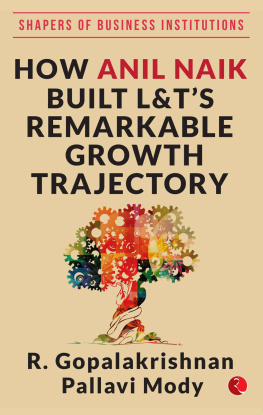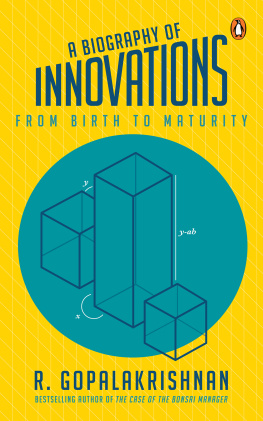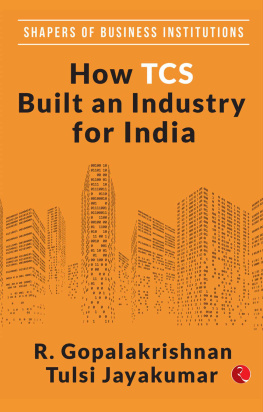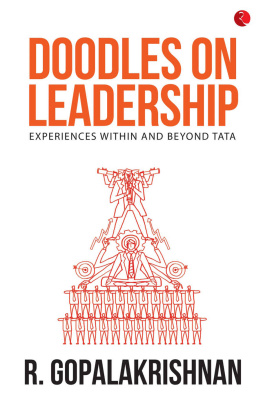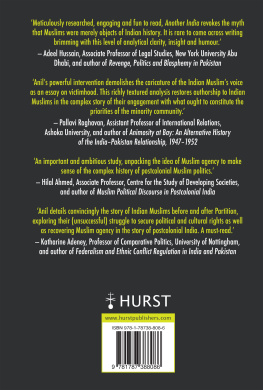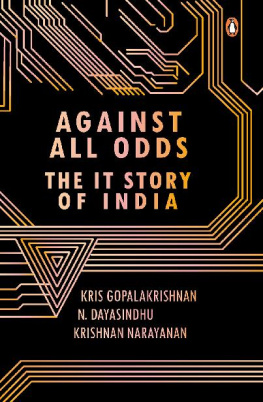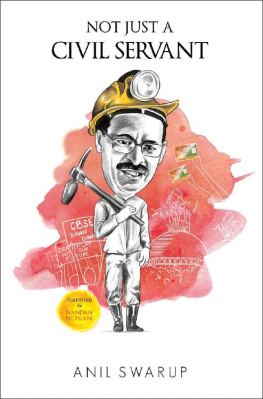R. Gopalakrishnan - HOW ANIL NAIK BUILT L&TS REMARKABLE GROWTH TRAJECTORY
Here you can read online R. Gopalakrishnan - HOW ANIL NAIK BUILT L&TS REMARKABLE GROWTH TRAJECTORY full text of the book (entire story) in english for free. Download pdf and epub, get meaning, cover and reviews about this ebook. year: 2019, publisher: Rupa Publications, genre: Politics. Description of the work, (preface) as well as reviews are available. Best literature library LitArk.com created for fans of good reading and offers a wide selection of genres:
Romance novel
Science fiction
Adventure
Detective
Science
History
Home and family
Prose
Art
Politics
Computer
Non-fiction
Religion
Business
Children
Humor
Choose a favorite category and find really read worthwhile books. Enjoy immersion in the world of imagination, feel the emotions of the characters or learn something new for yourself, make an fascinating discovery.
- Book:HOW ANIL NAIK BUILT L&TS REMARKABLE GROWTH TRAJECTORY
- Author:
- Publisher:Rupa Publications
- Genre:
- Year:2019
- Rating:3 / 5
- Favourites:Add to favourites
- Your mark:
- 60
- 1
- 2
- 3
- 4
- 5
HOW ANIL NAIK BUILT L&TS REMARKABLE GROWTH TRAJECTORY: summary, description and annotation
We offer to read an annotation, description, summary or preface (depends on what the author of the book "HOW ANIL NAIK BUILT L&TS REMARKABLE GROWTH TRAJECTORY" wrote himself). If you haven't found the necessary information about the book — write in the comments, we will try to find it.
R. Gopalakrishnan: author's other books
Who wrote HOW ANIL NAIK BUILT L&TS REMARKABLE GROWTH TRAJECTORY? Find out the surname, the name of the author of the book and a list of all author's works by series.
HOW ANIL NAIK BUILT L&TS REMARKABLE GROWTH TRAJECTORY — read online for free the complete book (whole text) full work
Below is the text of the book, divided by pages. System saving the place of the last page read, allows you to conveniently read the book "HOW ANIL NAIK BUILT L&TS REMARKABLE GROWTH TRAJECTORY" online for free, without having to search again every time where you left off. Put a bookmark, and you can go to the page where you finished reading at any time.
Font size:
Interval:
Bookmark:
HOW ANIL NAIK
BUILT L&TS
REMARKABLE
GROWTH
TRAJECTORY

Published by
Rupa Publications India Pvt. Ltd 2020
7/16, Ansari Road, Daryaganj
New Delhi 110002
Copyright R. Gopalakrishnan and Pallavi Mody 2020
The views and opinions expressed in this book are the authors own and the facts are as reported by them which have been verified to the extent possible, and the publishers are not in any way liable for the same.
All rights reserved.
No part of this publication may be reproduced, transmitted, or stored in a retrieval system, in any form or by any means, electronic, mechanical, photocopying, recording or otherwise, without the prior permission of the publisher.
ISBN: 978-93-5333-856-5
First impression 2020
10 9 8 7 6 5 4 3 2 1
The moral right of the authors have been asserted.
This book is sold subject to the condition that it shall not, by way of trade or otherwise, be lent, resold, hired out, or otherwise circulated, without the publishers prior consent, in any form of binding or cover other than that in which it is published.
Contents
Preface
This book is third in a series titled Shapers of Business Institutions that looks into the mindset, behaviour and actions of a Shaper of an Institution. These books are neither academic nor are they anecdotal new management mantra. Management, we believe, is performing arts, rather than a science. The distinctive feature of all the books in this series is that they are co-authored by an accomplished management practitioner and a serious academician. As authors, we reflected on our real-life observations about long-lasting and value-based companies and thought through the hypotheses that we could posit from those observations. We designed a conceptual business model and validated the model through field interviews. The result can be seen in the form of these books. The series has been envisaged based on the powerful idea of experience before theory. It is positioned at the intersection of practice and theory.
SHAPING A BUSINESS INSTITUTION
The theme of the series is about the shaping of good companies into business institutions. Were we to use imagery to distinguish between institutions and companies, an institution would be solid, long-lasting and structurally strong, metaphorically like Delhis Red Fort. On the other hand, a good company would resemble a modern, convenient and practical building. Buildings may crumble or become monuments and evolve into institutions. They may become role models for others interested in converting their own buildings into institutions. The central theme of these books is to identify the factors that help businesses become institutions.
As per the Bombay Stock Exchange (BSE) data, India has about 5,000 listed companies. How many of those companies can evolve to become institutions? What does it take for such a transformation? Does it matter if more companies are shaped into institutions in India? We believe that Indias economic development and job creation crucially depend on the performance of India Inc. It is important for Indian businesses to evolve into business institutions to lead the nation to higher prosperity.
In the mid-2018, a group of academics from Bharatiya Vidya Bhavans S.P. Jain Institute of Management and Research (SPJIMR) debated ideas around this theme. There are centurion companies and groups, which we refer to as Gen-C companies. These companies bear all the hallmark characteristics of institutions. These Gen-C institutions are storied brand names such as Tata, Godrej, Birla, Bajaj and TVSall founded about a hundred years ago and thriving to this day.
The current interest, however, lies in the search for Gen-L institutions; L standing for liberalization. The idea was to identify institutions, which were born, or which experienced exemplary growth at the time of Indias liberalization in the 1990s. Such companies should have a public image that is generally free of controversy and should have been around long enough for the researchers to make a reasoned judgment. The founder or the leadership team should have shaped the group or company into a sustainable, value-based and high performing institution. It was also important for the authors that the Shaper be alive and be able to personally speak about the subject. The books in the series are not commentaries or hagiographies about the Shapers; instead, they are intended to be more about the institutions and the institutionalization of mindset, behaviour and actions.
It is important to mention that the SPJIMR team did not intend to make judgements and comparisons as juries of awards do. Rather, it was merely trying to identify some institutions, which met certain broad criteria as exemplars that provided a basis for the researchthere would surely be more exemplars, not yet identified. The process followed therefore was to identify potential Gen-L institutions, get a consensus on the list among the relevant faculty group, and then write to the Shaper, inviting the group or companys participation.
This series is a joint imprint by two well-established Indian institutionsBharatiya Vidya Bhavans SPJIMR and Rupa Publications, Indias oldest book publisher and distributor. We, the authors, and the publisher of the series hope that the reader derives both inspiration and learning from the lessons showcased by the six institutions in this series.
A BENCHMARK SHAPER
We found it instructive to recall the portrait of an established and historic institution builder that helped us validate our approach by identifying some hallmarks of an established Shaper. Andrew Carnegie, the nineteenth-century steel magnate of the United States (US), would surely be regarded as the Shaper of the great steel institution, Carnegie Steel. He was a fine businessman and a true Shaper of an entire industry as he could imagine a future that few could see in the 1870s. Even a critic of Carnegie would concede that he was indeed an institution builder of his time. The rich writings by Carnegie suggest some special and relevant characteristics.
Virtuous impatience: Carnegie was impatient for his country to develop fast and ahead of Britain where he had been born into and which he had left behind. He expressed his impatience to usher in a great new future through a famous line in his book Trimphant Democracy published in 1886, The old nations of the world creep on at a snails pace; the republic thunders past with the rush of an express. The mindset of the Shaper was that of a man in a hurry.
Searing, single-minded vision: Carnegies genius was in recognizing early on that steel would be at the centre of the worlds real work. Having judged steel to be the future, he also realized that to be the king of the era of steel, he would have to marshal all his resources. There was no place for distraction.
Institutional duty versus personal loyalty: While building a great institution, the conflict between personal loyalty and institutional duty will inevitably arise. By the time Carnegie was 35 years old, he had become quite wealthy by the standards of the 1870s through his sheer hard work and pragmatism. Meanwhile, his early mentor and benefactor, Tom Scott had run into financial problems. Tom Scott needed financial help from Carnegies successful company. With steely resolve, Carnegie regretted the request because he felt that he owed a duty to his current partners rather than gratitude to his old mentor. This is an admirable early form of modern corporate governance.
The pursuit of money: Carnegie believed that it was a disgrace to be rich. Of course, he wanted to earn wealth, but his desire to push for progress and excellence far outweighed his desire for wealth. He deeply felt that amassing wealth was idolatry. To him, the work was important; the money was a mere consequence. Carnegie said that money could make money while work brought the glory. He respected vision but also observed that the asylums of the world are filled with people who had visionthinking big must be accompanied by executing and concentrating all resources for the accomplishment of that task.
Next pageFont size:
Interval:
Bookmark:
Similar books «HOW ANIL NAIK BUILT L&TS REMARKABLE GROWTH TRAJECTORY»
Look at similar books to HOW ANIL NAIK BUILT L&TS REMARKABLE GROWTH TRAJECTORY. We have selected literature similar in name and meaning in the hope of providing readers with more options to find new, interesting, not yet read works.
Discussion, reviews of the book HOW ANIL NAIK BUILT L&TS REMARKABLE GROWTH TRAJECTORY and just readers' own opinions. Leave your comments, write what you think about the work, its meaning or the main characters. Specify what exactly you liked and what you didn't like, and why you think so.

